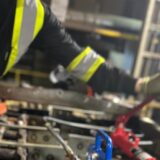Why Temporary Stairs and Handrails Are Critical for Jobsite Safety in Industrial Construction
In industrial construction, safety isn’t just a requirement—it’s a responsibility. Temporary stairs and handrails may not seem like major components on a jobsite, but they are essential for keeping workers safe and projects on schedule. Whether used during steel fabrication, facility upgrades, or shutdowns, these temporary systems help provide safe access and mobility across active work zones.
The Role of Temporary Stairs in Industrial Job Sites
Temporary stairs allow workers to access various levels of a structure before permanent stairways are installed. Their proper use is especially relevant during fast-paced industrial projects like those handled by Credence Construction Ltd., where safety and productivity must go hand in hand.
However, temporary stairs must be built with care. Common issues include:
- Poor anchoring: Stairs not secured properly at the base or top can shift or collapse under load.
- Inconsistent measurements: Uneven risers and treads cause trips and falls.
- Unmaintained surfaces: Snow, mud, or debris on steps increases slip hazards.
Why Handrails Matter Just as Much
Handrails aren’t just a nice-to-have—they’re a must. Properly placed handrails reduce fall risks by giving workers stable points of contact when navigating stairs.
Based on the SCSA Temporary Stairs and Handrails Toolbox Talk (PDF), handrails must meet specific standards:
- Installed on stairways with five or more treads
- Height between 800mm and 920mm above the tread’s front edge
- Able to withstand the force of a falling worker
- Must extend the full length of the stairway and be securely fastened
Temporary handrails made from clean, solid lumber or metal tubing can fulfill these requirements. However, handrails must never be used to hang tools or materials—they are for support, not storage.
Key Safety Standards for Temporary Stairs and Handrails
The Saskatchewan Occupational Health and Safety Regulations, 2020 outline specific expectations for temporary stair systems on job sites. Highlights include:
- Stair width must be at least 600mm
- Treads and risers should be uniform in size
- Handrails must offer a secure grip and have a clearance of 38 to 50mm from walls or objects
- Materials must be defect-free and installed by qualified personnel
These standards aren’t just checkboxes—they are practical measures to protect lives. By complying with these requirements, construction firms demonstrate a commitment to both their workers and the quality of their projects.
Best Practices for Temporary Stair and Handrail Installation
Here are a few on-site habits that should become part of every crew’s routine:
- Daily inspections: Look for damage, missing pieces, or shifting structures.
- Environmental checks: Clear mud, snow, and other debris regularly.
- Secure all connections: Temporary stairs should never rest loosely over floor openings.
- Training: Only qualified workers should install or modify stair or handrail systems.
At Credence Construction Ltd., these practices align with our approach to project safety across services like industrial scaffolding and construction solutions.
Building Safer Sites Through Smart Planning
Whether you’re planning a greenfield project or managing routine maintenance, every temporary access point should be evaluated with safety in mind. By taking the time to install proper temporary stairs and handrails, you reduce the risk of falls, protect your workforce, and meet the legal standards set for industrial job sites.
Conclusion
Temporary stairs and handrails may be temporary—but the impact of overlooking their safety is long-lasting. In industrial construction, small safety measures create a strong foundation for big results. Integrating these systems properly supports both your people and your project goals. At Credence Construction Ltd., we prioritize safety from the ground up—because every step matters.



